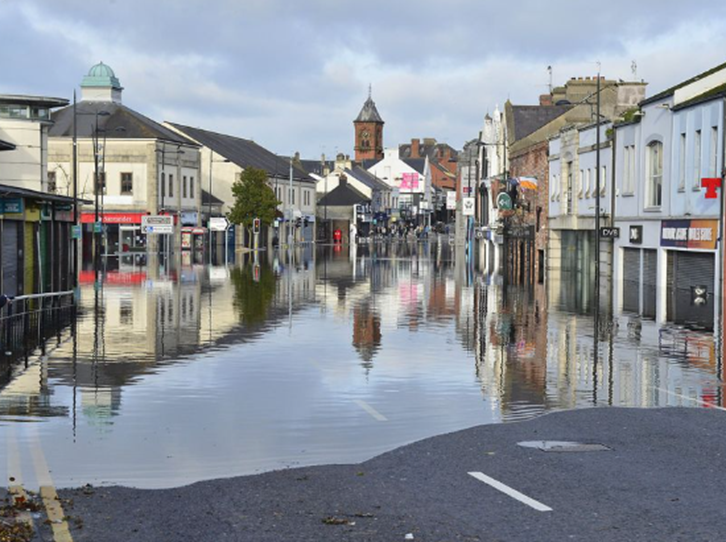- BY Kevin Barry BSc(Hons) MRICS
- POSTED IN Latest News
- WITH 0 COMMENTS
- PERMALINK
- STANDARD POST TYPE

A QS critical assessment of the Downpatrick Flood Alleviation Scheme Feasibility Report (May 2025) reveals a number of strengths, limitations, and underlying risks that merit serious scrutiny — particularly if the project is to proceed beyond feasibility.
🔍 CRITICAL ANALYSIS
✅ Strengths of the Report
- Robust Methodology
- Includes topographical, hydraulic, environmental, and economic modelling.
- Use of independent consultants (JBA, Amey) and clear evidence-based comparison between options.
- Transparency
- Presents assumptions, costs, flood extents, and modelled outcomes in detail.
- Includes detailed breakdown of Benefit Cost Ratios (BCRs), carbon analysis, and intangible (non-monetary) impacts.
- Clear Recommendation
- Option N is logically chosen based on both technical merit and economic viability (BCR of 1.15).
- Avoids over-reliance on reactive or manual flood protection (e.g., demountables in Option F).
⚠️ MAJOR WEAKNESSES AND LIMITATIONS
1. Extremely Marginal Economic Case
- Option N BCR is just 1.15, and Option F is 1.01 — both barely above the minimum threshold.
- A modest change in assumptions (e.g., construction inflation, downgraded property valuations, pump reliability issues) could push these BCRs below 1.0, rendering the scheme economically unviable.
- No clear contingency if the BCR drops in future stages.
Critical View: A flood alleviation scheme with such marginal economic justification requires stronger safeguards or political will to justify public investment.
2. High Capital Cost with Operational Complexity
- Option N will cost ~£22.5 million, a significant outlay for a town of Downpatrick’s size.
- Reliance on multiple mechanical pumps (e.g., 2–3 m³/s capacity) introduces long-term risks related to:
- Maintenance requirements
- Energy costs
- Mechanical failure
- No full-life cost model provided beyond Present Value Maintenance.
Critical View: Flood schemes reliant on mechanical solutions can become costly liabilities over 50–100 years, especially if not future-proofed.
3. Lack of Social or Political Strategy
- No defined public engagement strategy post-feasibility.
- No alignment with broader urban development, transport infrastructure, or community wellbeing plans.
- A gap between technical modelling and political or social delivery is evident.
Critical View: Technocratic solutions without political and community buy-in often stall or face delays at the business case or funding stage.
4. Dredging and Barrier Options Dismissed without Public Alternatives
- Local and MLA-backed calls for dredging or barrier modification were dismissed based on technical modelling.
- However, the report fails to propose alternative solutions that meet public expectations, such as visual amenity, ecological restoration, or traffic improvements.
Critical View: Public-facing infrastructure should not only be judged on BCR but also on legacy and acceptability. The report’s handling of politically sensitive options (e.g., dredging) is technically sound but tactically poor.
5. Carbon and Environmental Assessments Are Shallow
- Carbon analysis uses a simplistic footprint calculator, not a proper life-cycle assessment.
- Biodiversity impacts, especially to SAC/ASSI-designated zones and archaeological assets, are acknowledged but deferred to future assessments.
Critical View: In an era of net-zero policy commitments, this level of carbon/environmental analysis is inadequate and unlikely to satisfy rigorous planning or Green Book scrutiny.
6. Residual Flood Risk Not Fully Addressed
- Both shortlisted options leave 4–6 properties still at risk — mainly outside the protected areas.
- Report suggests property-level protection (e.g., flood doors) for these, but gives no cost, timeline, or integration plan.
Critical View: For a public-funded scheme aiming for whole-town protection, such gaps are problematic without a coherent residual risk mitigation plan.
🧾 CONCLUSION: FEASIBLE BUT FRAGILE
The report is a solid engineering and economic feasibility exercise, but it is strategically fragile in several ways:
- The scheme’s economic viability is precarious, with no room for budget drift or delay.
- Mechanical reliance poses long-term operational vulnerabilities.
- Community expectations around dredging and visible flood defences are not addressed with any narrative or alternatives.
- Environmental and heritage constraints are acknowledged but not deeply resolved.
Recommendation (Critical):
This report should not proceed directly to detailed design without:
- A robust business case sensitivity analysis (incl. BCR resilience testing).
- A full whole-life carbon and maintenance cost model.
- A stakeholder engagement and communications strategy.
- Clarified funding pathways — possibly aligning with regional climate adaptation or resilience schemes.
